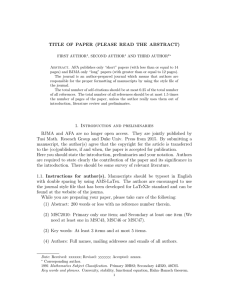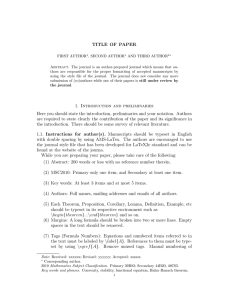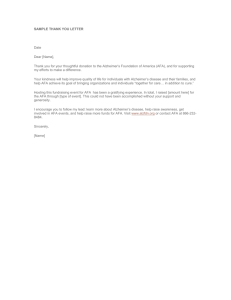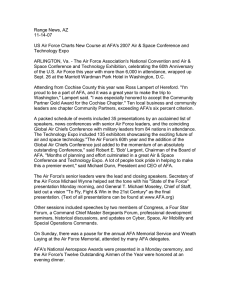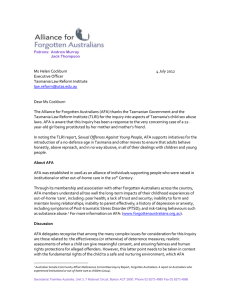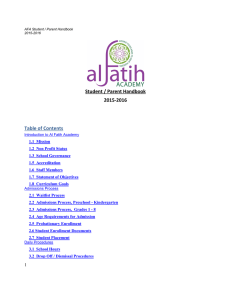This is a submission to one of journals of TMRG:... TITLE OF PAPER
advertisement
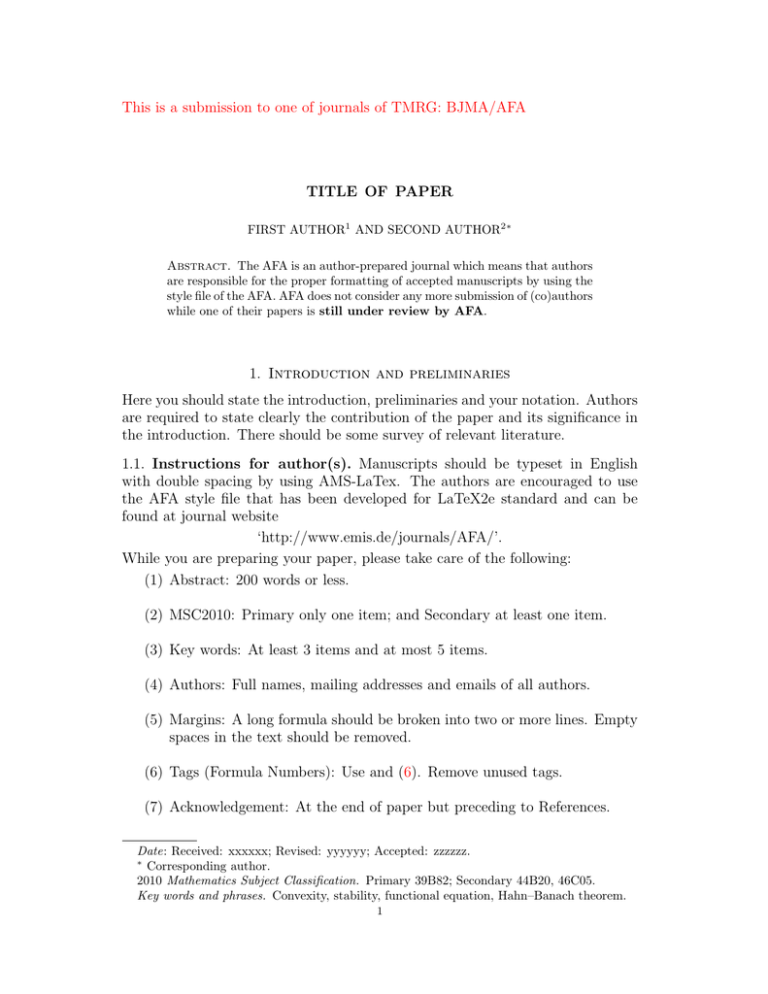
This is a submission to one of journals of TMRG: BJMA/AFA
TITLE OF PAPER
FIRST AUTHOR1 AND SECOND AUTHOR2∗
Abstract. The AFA is an author-prepared journal which means that authors
are responsible for the proper formatting of accepted manuscripts by using the
style file of the AFA. AFA does not consider any more submission of (co)authors
while one of their papers is still under review by AFA.
1. Introduction and preliminaries
Here you should state the introduction, preliminaries and your notation. Authors
are required to state clearly the contribution of the paper and its significance in
the introduction. There should be some survey of relevant literature.
1.1. Instructions for author(s). Manuscripts should be typeset in English
with double spacing by using AMS-LaTex. The authors are encouraged to use
the AFA style file that has been developed for LaTeX2e standard and can be
found at journal website
‘http://www.emis.de/journals/AFA/’.
While you are preparing your paper, please take care of the following:
(1) Abstract: 200 words or less.
(2) MSC2010: Primary only one item; and Secondary at least one item.
(3) Key words: At least 3 items and at most 5 items.
(4) Authors: Full names, mailing addresses and emails of all authors.
(5) Margins: A long formula should be broken into two or more lines. Empty
spaces in the text should be removed.
(6) Tags (Formula Numbers): Use and (6). Remove unused tags.
(7) Acknowledgement: At the end of paper but preceding to References.
Date: Received: xxxxxx; Revised: yyyyyy; Accepted: zzzzzz.
∗
Corresponding author.
2010 Mathematics Subject Classification. Primary 39B82; Secondary 44B20, 46C05.
Key words and phrases. Convexity, stability, functional equation, Hahn–Banach theorem.
1
2
F. AUTHOR, S. AUTHOR
(8) References: Use [3] to refer to the specific book/paper [2] in the text. Remove unused references. References should be listed in the alphabetical
order according to the surnames of the first author at the end of the paper
and should be cited in the text as, e.g., [2] or [3, Theorem 4.2], etc.
(9) Abbreviations: Abbreviations of titles of periodicals/books should be
given by using Math. Reviews, see Abbreviations of names of serials
or MRLookup.
2. Main results
The following is an example of a definition.
Definition 2.1. Let X be a real or complex linear space. A mapping k · k : X →
[0, ∞) is called a 2-norm on X if it satisfies the following conditions:
(1) kxk = 0 ⇔ x = 0,
(2) kλxk = kλkkxk for all x ∈ X and all scalar λ,
(3) kx + yk2 ≤ 2 (kxk2 + kyk2 ) for all x, y ∈ X .
Here is an example of a table.
Table 1.
1
2
3
f (x) g(x) h(x)
a
This is an example of a matrix
1 −2
3 5
b
5 2
0 3
c
5 2
0 3
The following is an example of an example.
Example 2.2. Let θ : A → A be a homomorphism. Define ϕ : A → A by
ϕ(a) = a0 θ(a). Then we have
ϕ(a1 . . . an ) =
=
=
=
a0 θ(a1 . . . an )
an0 θ(a1 ) . . . θ(an )
a0 θ(a1 ) . . . a0 θ(an )
ϕ(a1 ) . . . ϕ(an ).
(2.1)
Hence ϕ is an n-homomorphism.
The following is an example of a theorem and a proof. Please note how to refer
to a formula.
Theorem 2.3. If B is an open ball of a real inner product space X of dimension
greater than 1, Y is a real sequentially complete linear topological space, and
f : B \ {0} → Y is orthogonally generalized Jensen mapping with parameters
SHORT TITLE
3
s = t > √12 r, then there exist additive mappings T : X → Y and b : R+ → Y
such that f (x) = T (x) + b (kxk2 ) for all x ∈ B \ {0}.
Proof. First note that if f is a generalized Jensen mapping with parameters t =
s ≥ r, then
f (λ(x + y)) = λf (x) + λf (y)
≤ λ(f (x) + f (y))
= f (x) + f (y)
(2.2)
for some λ ≥ 1 and all x, y ∈ B \ {0} such that x ⊥ y.
Step (I)- the case that f is odd: Let x ∈ B \ {0}. There exists y0 ∈ B \ {0} such
that x ⊥ y0 , x + y0 ⊥ x − y0 . We have
x + y0
x − y0
f (x) = f (x) − λ f
− λf
2λ
2λ
y x + y0
x
0
2
+λf
− λ2 f
−
λ
f
2
2λ
2λ
2 λ2
x x − y0
−y0
2
2
+λf
−λ f
−λ f
2λ
2 λ2
2 λ2
x + 2 λ2 f
2
x2 λ
= 2 λ2 f
.
2 λ2
Step (II)- the case that f is even: Using the same notation and the same reasoning as in the proof of Theorem 2.3, one can show that f (x) = f (y0 ) and the
mapping Q : X → Y defined by Q(x) := (4λ2 )n f ((2λ2 )−n x) is even orthogonally
additive.
Now the result can be deduced from Steps (I) and (II) and (2.2).
The following is an example of a remark.
Remark 2.4. One can easily conclude that g is continuous by using Theorem 2.3.
Again, note how we refer to Theorem 2.3 and formula (2.1).
Acknowledgement. Acknowledgements could be placed at the end of the text
but precede the references.
References
1. U. Haagerup, Solution of the similarity problem for cylic representations of C ∗ -algebras,
Ann. of Math. (2) 118 (1983), no. 2, 215–240.
2. G.J. Murphy, C ∗ -Algebras and Operator Theory, Academic Press, Boston, 1990.
3. M. Mirzavaziri and M.S. Moslehian, Automatic continuity of σ-derivations in C ∗ -algebras,
Proc. Amer. Math. Soc. 134 (2006), no. 11, 3319–3327.
4. M.S. Moslehian, Ky Fan inequalities, Linear Multilinear Algebra (to appear).
4
F. AUTHOR, S. AUTHOR
5. Th.M. Rassias, Stability of the generalized orthogonality functional equation, Inner product
spaces and applications, 219–240, Pitman Res. Notes Math. Ser., 376, Longman, Harlow,
1997.
6. J.P. Vial, Strong convexity of set and functions, J. Math. Econom 9 (1982), no. 1-2, 187–205.
1
Department of Mathematics, National Institute of Technology, Jalandhar
144011, Punjab, India.
E-mail address: first1@afa.ac.ir; first2@afa.ac.ir
2
Department of Pure Mathematics, Ferdowsi University, P. O. Box 1159,
Mashhad 91775, Iran;
Tusi Mathematical Research Group (TMRG), Mashhad, Iran.
E-mail address: second@afa.ac.ir
